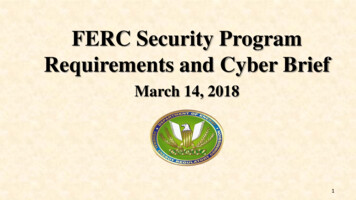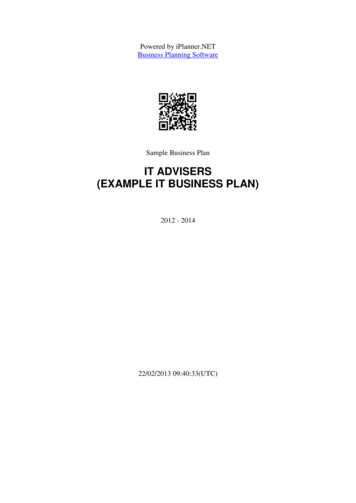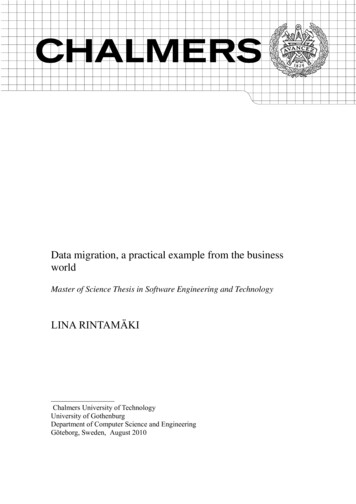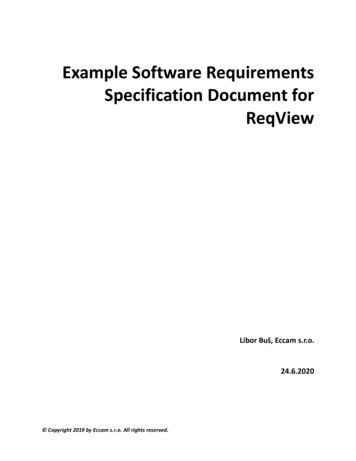
Transcription
Example Security Plan
Section 1PURPOSE:This Security Plan constitutes the "Standard Operating Procedures" relating to physical, cyber, andprocedural security for all (Utility) hydro projects. It contains a comprehensive overview of the(Utility)'s security program, and in some sections, makes reference to other relevant plans andprocedures. Security personnel, operators, and selected hydro personnel shall be familiar with theinformation and procedures associated with this Security Plan.Distribution: A copy of this plan shall reside in each of the following locations: Headquarters Security Operations CenterHydro Project Control RoomsSystems Operations CenterEmergency Action Plan ManagerPlant ManagersGeneral Counsel (Legal)Chief Risk OfficerRevision Date: April 29, 2010
Section 2SITE MAPS:These site maps reveal the restricted areas of each hydro project, as well as the physical securitylayouts that protect such areas. The measures listed below are incorporated into the security layouts,and shall be utilized to control and enforce access to the restricted areas: Guard posts (with barriers and "Tiger Teeth") - located at each access pointPlacement of fencing, locked gates, barricades, and signagePlacement of signage and buoy lines - upstream and downstream of damElectronic Access - Identification/access badges issued to employees and approvedcontractors. Doors and barrier arms can be activated by: 1) employee displaying accessbadge, or 2) operated by on-site guard, or 3) operated remotely from Security OperationsCenter."Hydro Access Request" - screening process for contractors and visitorsSecurity camera monitoring - 1) Security staff (Security Operations Center), 2) control roomoperators, 3) Systems Operations Center personnel, 4) Regional dispatch center forlaw enforcement and fire services, and 5) the State Patrol.Intrusion alarm monitoring - 1) Alarm Central (contracted monitoring agency), 2) Security staff(Security Operations Center)Contracted guards -- inspection patrolsLaw enforcement - observation patrols
Section 3
Dam (Structure)Spill Gates/ControlsIntake UnitsTransformersPowerhouseGenerator FloorControl RoomSwitchyardTransmissionAbutmentsFishway StructurePenetrationsIrrigation StructurePenetrationsRecreation StructurePenetrationVisitor CenterMaintenance GalleriesDomestic WaterHazMat storageCPMECDP&RCyber SecuritySecurity PlanSecurity AssessmentAssessment (internal)Assessment (external)Response TimeResponseDelayDetectionPhysical SecurityPROJECTCriticalPhysical Dam RelatedAssetsExternal accessHYDRO
Section 4SECURITY SYSTEMS:The (Utility) utilizes a number of security systems designed to help fulfill its securitymission. These systems complement the policies, procedures, and measures that formthe (Utility)'s robust security program.The (Utility)'s security systems include:1. Fencing & GatesFencing is the first layer of security at all of our Hydro projects,Transmission/Distribution points, and (Utility) facilities. The (Utility) has standardizedon 8-foot fencing, using tension wire in lieu of bars, placing fence barbs up, andsecuring the bottom of the fencing below grade. Access points/gates are securedthrough one of the following methods: Manually opened and secured with a heavyduty (Utility) approved pad lock, electronically accessed with card credential, orelectronically accessed with remote gate fob. All perimeters and access points aremonitored 24/7 by CCTV or contracted security guards.2. Exterior LightingExterior lighting has been strategically placed throughout the (Utility) to emphasizeand highlight perimeters, gate and Guard Post access points, entry points intobuildings, and areas of interest. Lighting can be activated by motion or photo-cell.Exterior lighting serves as a deterrent, as well as to aid in monitoring of the (Utility)'sCCTV system.3. CCTVThe (Utility) has deployed over 100 CCTV cameras throughout the county. Thesecameras have Pan/Tilt/Zoom (PTZ) capabilities, and are strategically placedthroughout the projects. Via our unique Fiber Optic infrastructure, these camerasignals are sent back centrally to the (Utility)'s headquarters office where they arerecorded 24/7. From this central point, Security has the ability to monitor and controlall cameras. In addition, Security shares control and monitoring of these cameraswith the Hydro projects, System Operations (Dispatch), Engineering staff, as well asthree local law enforcement agencies and Regional Dispatch Center. This CCTVsystem is monitored 24/7.
4. Electronic Access ControlThe (Utility) utilizes a comprehensive Electronic Access Control system, which hasbeen installed throughout the projects and facilities. These card access pointssecure doors to buildings, access gates, and barrier arms. Through this technology,Security is able to effectively track and control access. Each employee andcontractor is required to wear an identification/access badge which is individuallytailored for specific access. The (Utility) has also installed a CIP-specific ElectronicAccess Control system which ensures restricted access to Critical Cyber Assetareas. These Electronic Access Control systems are monitored 24/7.5. Intrusion alarmsIntrusion alarms are utilized throughout the (Utility). These alarms serve twoimportant functions: Provide 24/7 monitoring in remote locations where staff is not always present.Installed in all CIP-designated spaces.The alarm sensors include door/window contacts, motion detection, and glass break.These Intrusion alarm systems are monitored 24/7.6. Security GuardsThe (Utility) contracts the services of a private security company. Guards arestationed at the Hydro Projects. Additionally, "patrol" guards are assigned to conductsecurity checks of the (Utility)'s properties -- including the hydro projects.7. Law Enforcement SupportThe (Utility) has developed strong partnerships with the local law enforcementagencies. These agencies support the (Utility)'s security mission throughcollaborative training & exercises, observation patrols, response to incidents, andproactive meetings.
(UTILITY) Closed Circuit Television (CCTV)CCTV cameras, controls and monitoring have been upgraded and expanded toincrease critical infrastructure protection and to: Provide enhanced security and safety at (Utility) facilities; Provide operational viewing of (Utility) projects; Provide safety alerts or response to a major event. Provide emergency responders with video coverage (where available) ofcritical incidents.Use of (Utility) CCTV is appropriate for security, safety, operational and/oremergency responses.Use of (Utility) CCTV is not appropriate for monitoring or assessing employeeproductivity.Use of (Utility) CCTV is not appropriate for monitoring, without cause, thelegitimate behavior or personal conduct of an individual or group ofindividuals.General Information:(Utility) cameras are viewed, controlled and/or recorded at:1. 911 Regional Dispatch Center 24/7(only the cameras being actually viewed on 's three monitors)2. State Patrol Regional Dispatch Office 24/7(only the cameras being actually viewed on WSP's three monitors)3. Hydro project control rooms (Operators) 24/74. County Emergency Management Office(only the cameras being actually viewed on CCEM's monitor)5. (UTILITY) Security Offices 24/7 / 3rd floor Comm Room (HQ)(Utility) Cameras may be viewed and controlled, but not recorded, at:6. (UTILITY) System Operation Control (Dispatch) 24/7 and Back-UpControl Center7. Distribution Crew Dispatch Office (HQ)8. Hydro Plant Operations Offices (5th floor)9. Visitor Center, Deputy Station, CM Conf Room10. Engineering Services Conference Room11. Fleet Services / T&D Operations / Tech Shop12. HQ Operations Exec Office
Section 5MAINTENANCE & TESTING:The (Utility)'s security systems and equipment shall be properly maintained and tested in order toensure its continuous and effective operation. Maintenance is performed in accordance with the manufacturer's recommendations andguidance. Whenever feasible, Maximo (computer program) is used to schedule and track routinemaintenance. Routine maintenance is performed by a trained group of (Utility) employees who possess thenecessary levels of mechanical and technical competence. These individuals are substantiallyassigned to one of the following work areas: Maintenance Department, Technician Shop,Facilities Department, and Security Division. Reference: The Security Division maintains a separate, comprehensive plan in accordancewith NERC Standard CIP-006-2, Physical Security Program for the Protection of CriticalCyber Assets. Maintenance and testing (R8) is described in this plan. The (Utility)'s Maintenance and Testing Program is consistent with FERC guidelines.
Section 6(Utility) Issued Keys:PurposeThis policy is to be used as a reference when issuing keys within the (Utility). It will alsoexplain our policy for returning keys, reporting lost or stolen keys, the use of unauthorizedduplicate keys and loaned keys.The key system will be entered into the computer-based Key Control Program for on-goingmaintenance and will be maintained by the Key Administrator. The Facilities Departmentwill program cores and cut keys, and the Key Administrator will issue keys.1. Issuing Authority - Keys will be authorized in writing for issuance to employees of the(Utility) by one of the following individuals:a) General Managerb) Executive Managers or their designeesc) Department Directors or their designeesIf keys are requested from one Business Group that would access another BusinessGroup, written approval will be required from Directors of each unit.All approvals will be routed through the Key Administrator. Only in an emergency will akey be issued by Building Maintenance Foreman without the Key Administrator's priorknowledge, and it will require the approval of a Department Director. When a key isissued under these circumstances, the Building Maintenance Foreman will notify theKey Administrator as soon as possible.2. Who is authorized to have specific keys - Access will be given only to areas where needcan be demonstrated.3. Keys will not be loaned and should not be left unattended - All keys issued on a"permanent" basis should be retained in the possession of the person to whom issued.Keys may not be transferred directly from one employee to another. Avoid the practiceof leaving keys on desks, counter tops, etc, or loaning to others.4. Lost/Stolen Keys - Any person losing a key must report the loss to his or hersuperintendent/supervisor immediately, who will then report the loss to the KeyAdministrator. The Security Department along with the Facilities Department willmake a determination as to whether the system has been compromised and if a corechange is necessary. If a core change is required, that expense will be borne by thedepartment that misplaced the key.
5. Examples of Estimated Core Change Costsa) 2,500 - To re-key the substation master(Utility) Keys are valuable and should be safeguarded accordingly. Changing keys/coresincludes labor, travel time, and materials and requires rescheduling of resources.6. Duplicated keys - It is against (Utility) policy to duplicate keys.KEY CHECK-OUT PROCEDURESTo maintain consistency and provide predictability, specific checkout procedures shall befollowed:1. Temporary key checkout - Temporary key checkout shall be for a period of 24 hours orless. Any authorized individual will be permitted to check out a key on a temporarybasis. The Department Director or his designee shall grant authorization in writing. Theindividual receiving a temporary key shall provide photo identification at the time of keycheckout, upon request. Keys checked out on a temporary basis shall be returned withinthe 24-hour period. If the individual needs the key for a longer period of time, the key willbe checked in and subsequently checked out again.2. Temporary-loan keys - Vendors and contractors may be authorized to have temporaryloan keys. A Department Director or his designee may authorize in writing the use oftemporary loan keys only through the use of the attached temporary-loan keyauthorization form. Vendors/Contractors will acknowledge all keys received and reportall lost or stolen keys immediately. Vendor/Contractor will return all keys within five daysof termination of work. If keys are not returned within five days of project completion andit is determined a re-core is necessary, it shall be at the vendor/contractor's expense.3. Permanent Key Check-out - Permanent keys are issued to employees for the purpose ofallowing the employee to access the areas in which they are regularly assigned duties. Ifkeys are requested from one Business Unit that would access another Business Unit,written approval will be required from Directors of each unit. A record of all keys issuedwill be kept on an employee key authorization form (see attachment), and maintained bythe Key Administrator. New employees will be issued keys for their work needs asindicated by the Department's Director on the intent to hire form. Keys shall be issued tonew employees by the (Utility) Security Coordinator at the time the new employee isissued his or her I.D./access badge.
KEY CHECK-IN PROCEDURES1.Key(s) Check-in - When employment with the (Utility) has been terminated, all keyswill be returned and noted on the employee authorization form by the KeyAdministrator. Responsibility for collecting the key(s) shall rest with the Supervisor ofthe terminating employee. Failure on the part of a Supervisor to collect key(s) fromterminating employees may require a key core change, as per Section III,Lost/Stolen keys.ADMINISTRATIVE PROCEDURESKey Administrator and Building Maintenance Foreman will oversee the management ofthe keying system of the (Utility).The design of the (Utility) keying system recognizes four (4) systems, includingDistribution, Generation, Facilities, and Administration.Keys will be r
This Security Plan constitutes the "Standard Operating Procedures" relating to physical, cyber, and procedural security for all (Utility) hydro projects. It contains a comprehensive overview of the (Utility)'s security program, and in some sections, makes reference to other relevant plans and procedures. Security personnel, operators, and selected hydro personnel shall be familiar with the











